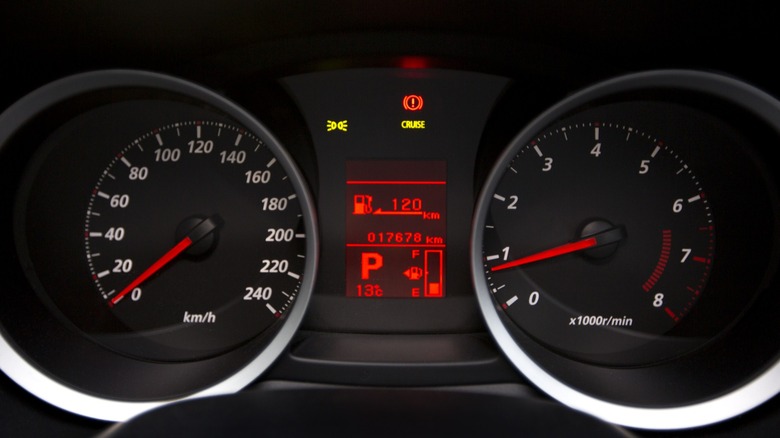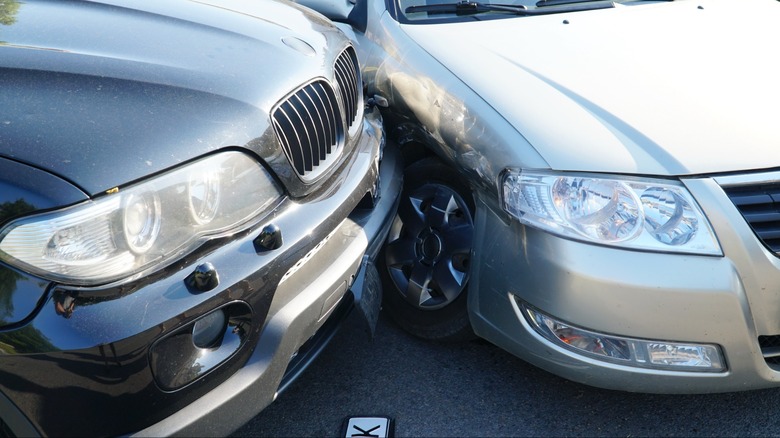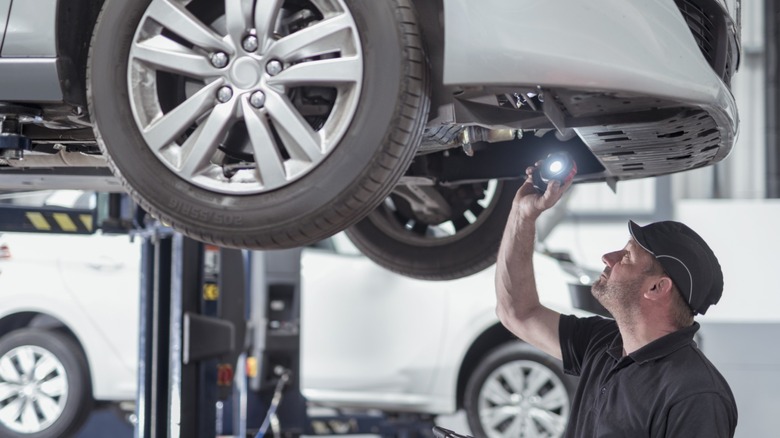5 Red Flags You Can't Ignore On A Carfax Report When Buying A Car
Buying a car — whether it's new or used — is a major investment. When you buy new, a warranty usually helps take away some of the fear and uncertainty. There are still things to be cautious about, but with a used car the risks are on a different level. Some of that anxiety comes from outdated myths about used cars. In fact, some cars are more valuable used than new. That said, the risks are still very real. Repairs for serious mechanical problems can easily run into thousands of dollars, and cars with troubled histories often have much lower resale values, putting you at a loss when it's time to sell. So, while a clean exterior and a smooth test drive might seem like good enough reasons to go ahead with a deal, there are things you need to consider when buying a used car.
That's where a Carfax report comes in. It's the documented history of a vehicle that reveals vital information that a seller might not share. Carfax and similar reports from other companies track accidents, title brands, ownership changes, service records, and odometer readings along the car's lifetime. Sure, some details might be routine matters, but there are others that should make you think twice about your potential purchase. That's why we've put together this guide to walk you through the biggest red flags you need to watch out for on any Carfax report. Once you know what to look for, you'll be better prepared to make a smarter, more confident purchase.
Title problems
Title problems are among the worst, as they can affect everything from the car's safety and reliability to its resale value and even your ability to insure, register, or finance it. There are several different types of car titles which vary from state to state, but you want to especially watch out for salvage, rebuilt, and flood damage brandings. A salvage title means the vehicle was declared a total loss by an insurance company after an accident, flood, or other major damage. The DMV typically assigns this title after an insurance company determines that the cost of repairing the damage is more than the car is worth.
A rebuilt title appears when a salvaged vehicle has been repaired and inspected to verify that it's roadworthy again. Some rebuilt cars are restored with care by professionals, while others get patched up just enough to pass inspection. It's hard to tell which you're getting unless you have access to the car's complete repair history.
Water or flood damage titles are especially troubling. A car might look fine at first, but water can cause long-term problems that aren't immediately visible. Electrical parts can corrode. Mold can grow in hidden areas. Metal can rust. Rubber seals, gaskets, and bushings can rot. Soon, the car just starts falling apart.
Then there's title washing, a deceptive practice where sellers move a car to a different state to clean up the title. Because not all states use the same rules for title branding, this loophole sometimes allows a car with a branded title in one place to get a clean one somewhere else. Before buying any used car, take a close look at the title and check it against the Carfax report. If anything seems fishy or unclear, it's worth walking away.
Multiple owners in a short period
When reading a Carfax report, one of the clearest signs of trouble is the ownership history. If a car has had several owners in a short period, that's a huge red flag. In the auto world, they call these cars "hot potatoes" because nobody wants to hold onto them for long. Think about it: why would someone spend thousands on a car and then sell it just months later? When you see two or more owners do the same thing in short succession, chances are good that they ran into problems and didn't want to deal with the cost or stress of fixing them. If a vehicle keeps getting passed from one owner to the next, that's a good sign something's off. The trouble with cars that have this kind of ownership history often goes beyond the mechanical.
With each change, maintaining a complete service history becomes increasingly difficult. Regular maintenance records may become scattered across different service centers or lost entirely, making it challenging to verify whether the vehicle received proper care. Even if you can confirm that a car has been properly serviced or you fix whatever issues come up, that long list of previous owners will still show up on subsequent Carfax reports. That alone can make it harder to resell, which means money out of your pocket later. Nonetheless, if you're considering a car with a long list of past owners, get a pre-purchase inspection from an independent mechanic who can spot potential issues. It's one of the smartest ways to protect yourself before closing the deal.
Odometer readings and discrepancies
One of the most deceptive practices in the used car market is odometer fraud. This still affects buyers today, even with newer vehicle technology. Many people assume digital odometers solved the problem, but that's not the case. In fact, Carfax reports that more than 2 million cars had rolled-back odometers as of December 2024. Odometer rollback, sometimes called "clocking" or "busting miles," happens when someone tampers with a car's odometer to make it show fewer miles than it's actually been driven. Lower mileage makes a car inherently more valuable. For example, JD Power values a 2015 Toyota Camry LE with 100,000 miles at $14,100, while that same car with 200,000 miles is worth just under $9,000.
Odometer fraud has serious consequences for buyers. You end up paying a premium price for a car that's far more worn than advertised. Parts that should last years might start failing in months. You'll hit major maintenance milestones much sooner than expected. And when you try to sell the car later, you may find it's worth far less than you paid. Study the mileage history section of the Carfax report carefully. The numbers should show a logical, consistent progression over time. If you notice mileage decreasing between service visits, large gaps in the record, a sudden big jump in mileage, or a figure that seems too low for the car's age, that's a red flag. You should also look beyond the report. Check for physical signs that don't match the mileage, such as worn-out pedals, sagging seats, a faded steering wheel, or heavily used buttons. These small clues can tell you a lot.
Accident history
A vehicle's accident history is one of the most important sections to check on a Carfax report. It gives you insight into the car's overall condition and its potential for future problems. Not all accidents are equal, though — the severity of the damage matters a lot. But even if a car doesn't have a salvage or rebuilt title, you should find previous collision repairs on the Carfax report. Some damage can compromise a car's safety in ways that aren't obvious right away. Take frame damage, for example. If the frame has been bent, it's sometimes impossible to bring it back to factory shape. That can lead to poor handling, uneven tire wear, and excessive vibrations. These kinds of problems may start small, but they often get worse and more expensive to fix over time.
Vehicles with accident histories also can experience recurring mechanical problems. What might appear as an unrelated issue months later can sometimes be traced back to previous collision damage. These problems can include electrical faults, rough gear shifts, and noisy suspension systems. There are also financial implications to buying a car that has been in an accident.
Insurance companies often charge higher premiums for vehicles with serious accident histories since they're more likely to have problems in the future. And when it's time to sell, cars with a history of damage usually lose value, even if they look fine on the outside. So what should you do? Option one is to steer clear. Option two is to check when the accident happened, how severe it was, and what kind of repairs were done. If you see anything about frame or structural damage, be extremely cautious. Get a qualified mechanic to inspect the car. They can identify signs of incomplete or inadequate repairs.
Suspicious maintenance history
When reviewing a Carfax report, pay close attention to the frequency and consistency of maintenance records; gaps in service history can be just as concerning as documented accidents or title problems. A well-maintained vehicle should show regular service intervals throughout its life, which will assure you that the previous owner(s) kept up with routine maintenance. When examining service records, compare the age and mileage of the vehicle to its reported maintenance. Newer vehicles might not have service records available, but if you find a car three years or older with a suspiciously sparse service history, you should immediately question why.
The absence of maintenance records could indicate several concerning scenarios. Some owners choose to ignore developing problems or routine maintenance. It's also possible the car was garaged or on a dealer's lot for a significant period. If you encounter a vehicle with limited service records on its Carfax report, don't simply accept this as a benign gap in documentation. Ask the seller specific questions about who performed maintenance on the vehicle and where it was serviced. Many sellers will be able to provide this information readily, even if the records don't show up on the Carfax report. You can always take the extra step of contacting these service facilities directly to verify the maintenance history.
Remember, while a clean Carfax doesn't guarantee a perfect car, a report with these red flags is giving you valuable warnings you shouldn't ignore. Remember that a Carfax report is just one tool in your buying process. Combine it with a pre-purchase inspection from a trusted mechanic and a thorough test drive so that you won't be purchasing a lemon. Your future self will thank you for being careful now and avoiding what could become an expensive surprise later.





